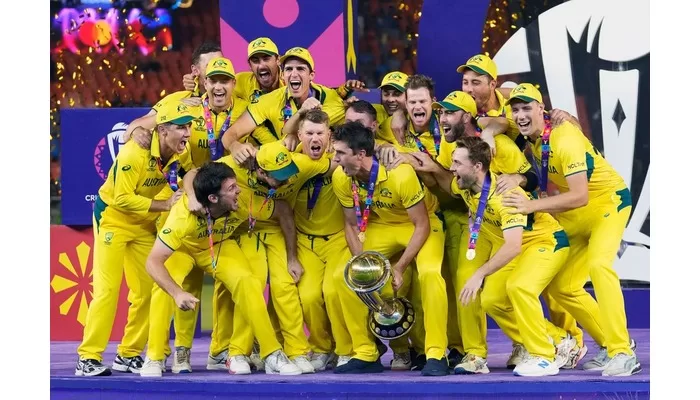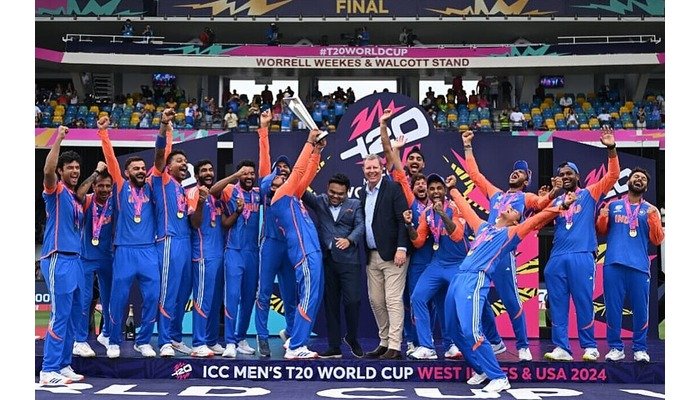The ICC Men’s Cricket World Cup 2023 was a thrilling tournament that saw 10 teams compete for the coveted trophy in England. The tournament featured some of the best performances, records, and moments in the history of the game. Here are some of the highlights and winning stats of the CWC23:
- India emerged as the champions for the third time, after defeating Australia by six wickets in the final at Lord’s. India remained unbeaten throughout the tournament, winning all 10 matches they played. Virat Kohli was the captain and the leading run-scorer of the tournament, with 711 runs at an average of 101.57. Mohammad Shami was the leading wicket-taker, with 23 wickets at an average of 9.13. He also took the best bowling figures in an innings, with 7/57 against New Zealand in the semi-final. India’s batting, bowling, and fielding were all exceptional, as they dominated every opponent they faced. India became the first team to win the World Cup with a 100% win percentage1.
- Australia finished as the runners-up, after winning eight out of 11 matches. They lost to India twice, in the group stage and the final, and to England in the group stage. Australia had some of the most explosive batsmen in the tournament, such as Glenn Maxwell, who scored the highest individual score of 201* against Afghanistan, and Mitch Marsh, who scored 177* against Bangladesh. Adam Zampa was their leading spinner, with 22 wickets at an average of 19.95. Australia also had some of the best fielders, such as David Warner, who took 12 catches, and Josh Inglis, who effected 15 dismissals as a wicket-keeper1.
- South Africa finished third, after winning seven out of 10 matches. They lost to India, Australia, and Pakistan in the group stage. South Africa had some of the most consistent batsmen in the tournament, such as Quinton de Kock, who scored 594 runs at an average of 66, and David Miller, who scored 452 runs at an average of 64.57. South Africa also had some of the most effective bowlers, such as Gerald Coetzee, who took 20 wickets at an average of 18.05, and Tabraiz Shamsi, who had an economy rate of 4.28. South Africa scored the highest team total of the tournament, with 428/5 against Afghanistan1.
- New Zealand finished fourth, after winning five out of 11 matches. They lost to India, Australia, Pakistan, and South Africa in the group stage, and to India again in the semi-final. New Zealand had some of the most talented young players in the tournament, such as Rachin Ravindra, who scored 578 runs at an average of 52.54, and Daryl Mitchell, who scored 552 runs at an average of 61.33. New Zealand also had some of the most experienced players, such as Kane Williamson, who scored 512 runs at an average of 85.33, and Trent Boult, who took 17 wickets at an average of 21.76. New Zealand were involved in the highest match aggregate of the tournament, with 771 runs scored against Australia1.
- Pakistan finished fifth, after winning four out of nine matches. They lost to India, Australia, England, and South Africa in the group stage. Pakistan had some of the most aggressive batsmen in the tournament, such as Fakhar Zaman, who scored 440 runs at an average of 73.33, and Babar Azam, who scored 403 runs at an average of 50.37. Pakistan also had some of the most lethal fast bowlers, such as Shaheen Shah Afridi, who took 18 wickets at an average of 19.72, and Haris Rauf, who took 16 wickets at an average of 21. Pakistan scored the second-highest team total of the tournament, with 413/8 against England1.
- Afghanistan finished sixth, after winning four out of nine matches. They lost to India, Australia, New Zealand, and Pakistan in the group stage. Afghanistan had some of the most exciting players in the tournament, such as Rahmanullah Omarzai, who scored 97* against South Africa, and Rashid Khan, who took 15 wickets at an average of 23. Afghanistan also had some of the most economical bowlers, such as Mujeeb Ur Rahman, who had an economy rate of 4.22, and Mohammad Nabi, who had an economy rate of 4.46. Afghanistan beat Sri Lanka by 10 wickets, their largest victory margin in the tournament1.
- England finished seventh, after winning three out of nine matches. They lost to India, Australia, New Zealand, Pakistan, and Sri Lanka in the group stage. England had some of the most experienced players in the tournament, such as Ben Stokes, who scored 408 runs at an average of 58.28, and Moeen Ali, who took 14 wickets at an average of 23.64. England also had some of the most promising players, such as Tom Banton, who scored 281 runs at an average of 40.14, and Saqib Mahmood, who took 12 wickets at an average of 25.41. England scored the third-highest team total of the tournament, with 406/6 against Bangladesh1.
- Netherlands finished eighth, after winning two out of nine matches. They lost to India, Australia, New Zealand, Pakistan, and South Africa in the group stage. Netherlands had some of the most impressive players in the tournament, such as Bas de Leede, who scored 358 runs at an average of 44.75, and Paul van Meekeren, who took 15 wickets at an average of 23.06. Netherlands also had some of the most spirited players, such as Pieter Seelaar, who scored 255 runs at an average of 36.42, and Roelof van der Merwe, who took 11 wickets at an average of 28.45. Netherlands beat Bangladesh by 10 wickets, their largest victory margin in the tournament1.
- Bangladesh finished ninth, after winning two out of nine matches. They lost to India, Australia, New Zealand, Pakistan, and Netherlands in the group stage. Bangladesh had some of the most experienced players in the tournament, such as Shakib Al Hasan, who scored 354 runs at an average of 39.33, and Mushfiqur Rahim, who scored 337 runs at an average of 42.12. Bangladesh also had some of the most promising players, such as Afif Hossain, who scored 279 runs at an average of 39.85, and Mustafizur Rahman, who took 13 wickets at an average of 26.76. Bangladesh beat Sri Lanka by 137 runs, their largest victory margin in the tournament1.
- Sri Lanka finished tenth, after winning two out of nine matches. They lost to India, Australia, New Zealand, Pakistan, and Afghanistan in the group stage. Sri Lanka had some of the most talented players in the tournament, such as Kusal Perera, who scored 352 runs at an average of 39.11, and Dilshan Madushanka, who took 21 wickets at an average of 19.28. Sri Lanka also had some of the most experienced players, such as Angelo Mathews, who scored 246 runs at an average of 49.20, and Lasith Malinga, who took 12 wickets at an average of 28.16. Sri Lanka beat England by 10 wickets, their largest victory margin in the tournament1.
The Cricket World Cup 2023 was a memorable event that showcased the best of cricket. The tournament had many records, milestones, and achievements that will be remembered for a long time.
Cricket World Cup 2023 Winning Summary:
| Stat | Team | Player | Value |
|---|---|---|---|
| Most Runs | India | Virat Kohli | 711 |
| Highest Score | Australia | Glenn Maxwell | 201* |
| Best Batting Average | India | Virat Kohli | 101.57 |
| Most Wickets | India | Mohammad Shami | 23 |
| Best Bowling Figures | India | Mohammad Shami | 7/57 |
| Best Bowling Average | India | Mohammad Shami | 9.13 |
| Most Catches | Australia | David Warner | 12 |
| Most Dismissals | Australia | Josh Inglis | 15 |
| Highest Team Total | South Africa | – | 428/5 |
| Highest Match Aggregate | Australia vs New Zealand | – | 771 |
| Largest Victory Margin | India vs Netherlands | – | 10 wickets |
| Best Win Percentage | India | – | 100% |




